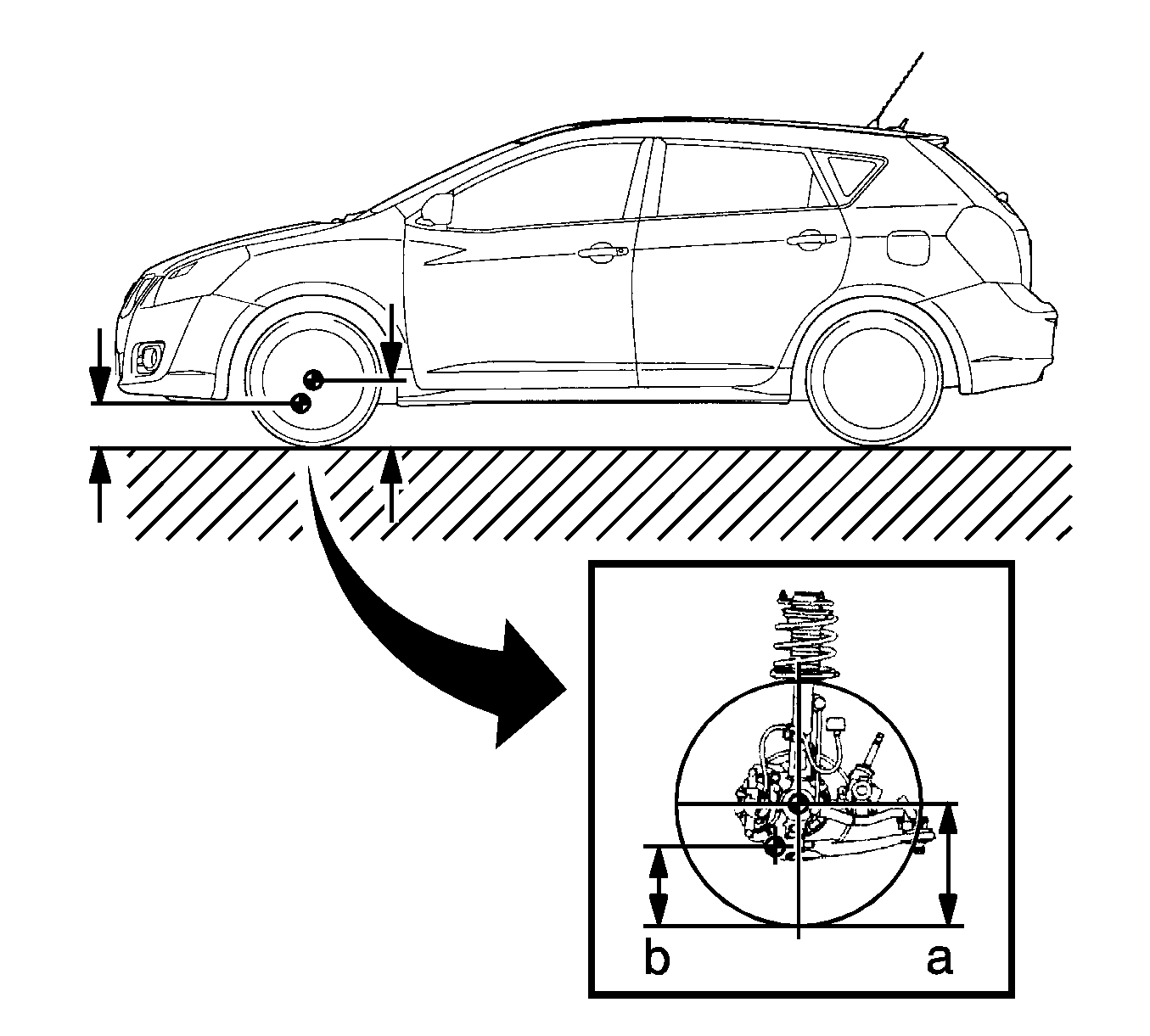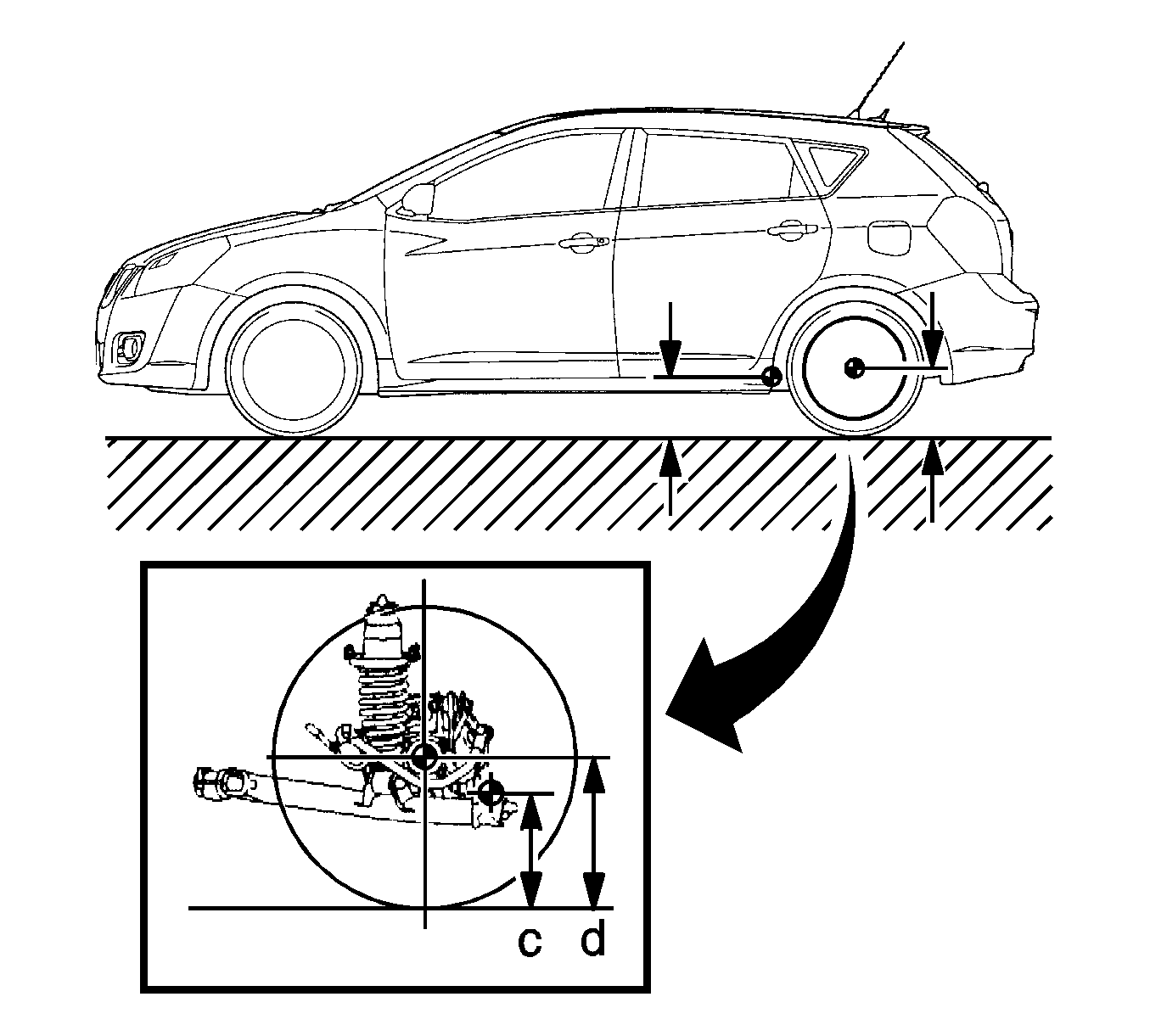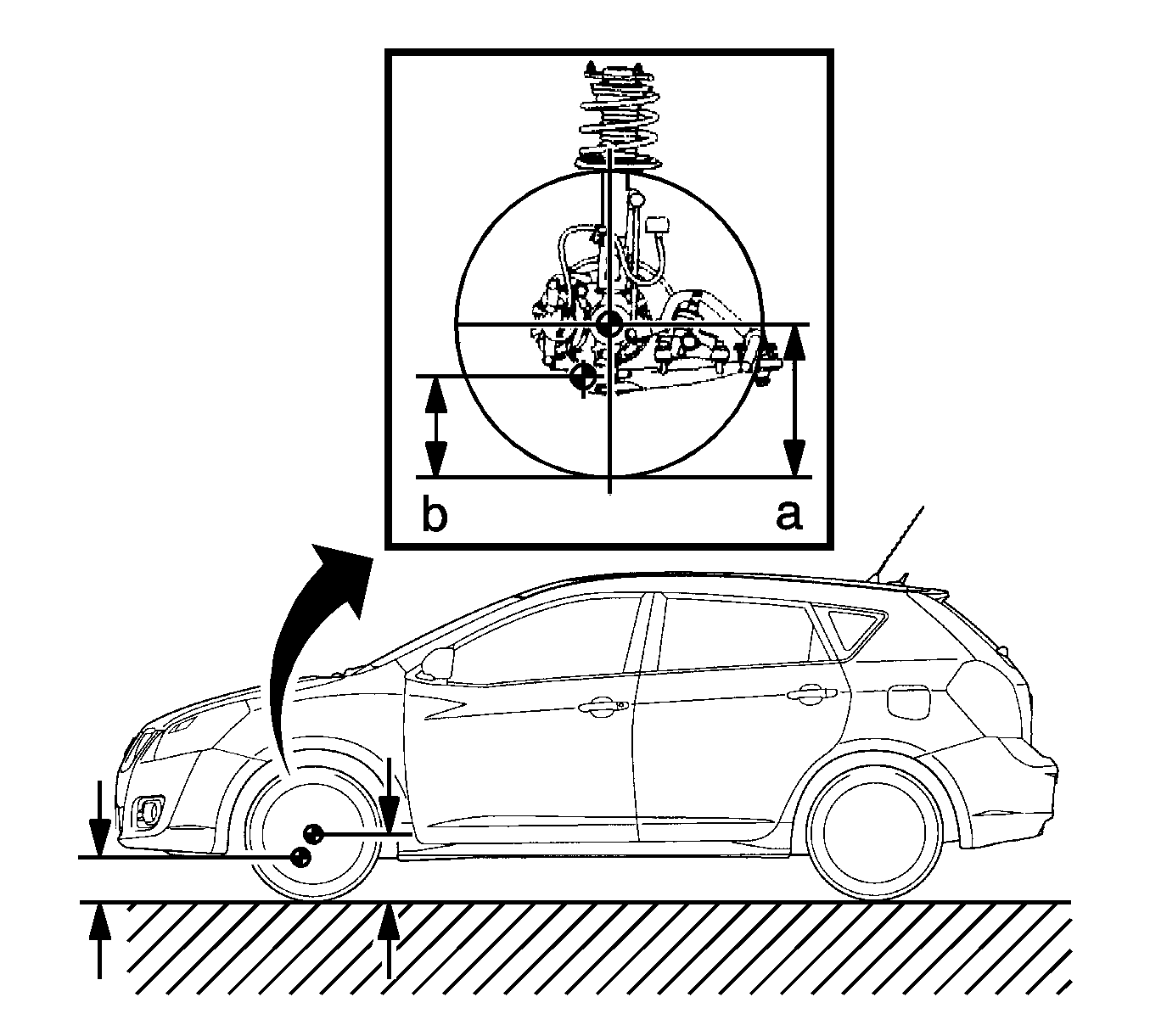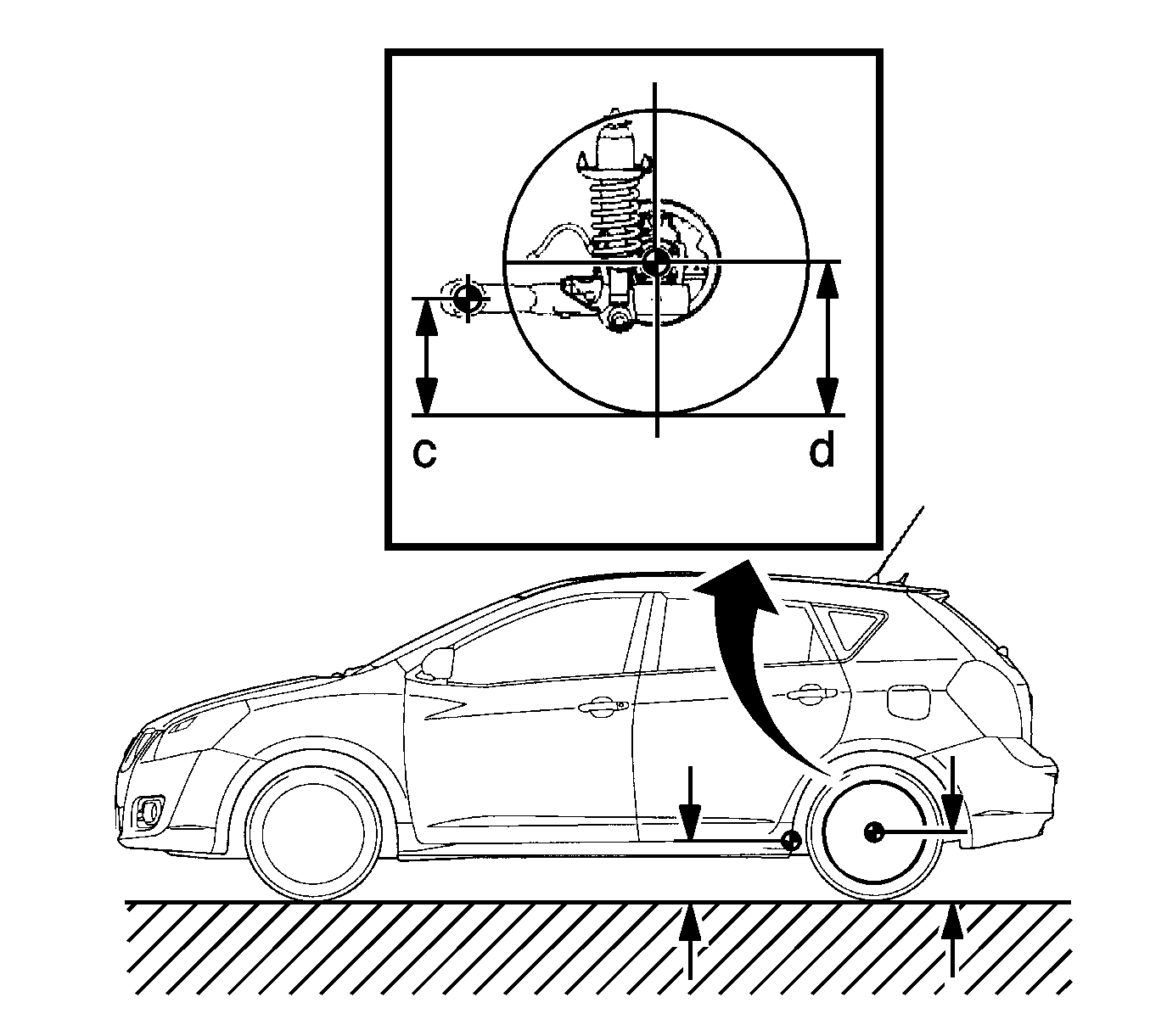Trim Height Inspection All Wheel Drive and GT
Preparation Procedure
Trim height is the vehicle ride height. Incorrect trim height can cause bottoming out over bumps. Incorrect trim height can cause damage to the suspension components and symptoms similar to those produced when there is a problem with the wheel alignment. Measure the trim height when diagnosing suspension complaints and before measuring the wheel alignment.
Perform the following steps before measuring the trim height:
- Set the tire pressure to the pressure specifications on the tire placard. Refer to Tire Placard.
- Verify the tires match the tire size specifications on the tire placard.
- Verify the wheels match the wheel size specifications on the tire placard.
- Verify the fuel tank is full. Add additional weight in order to simulate a full tank, if necessary.
- Verify the rear compartment is empty except for the spare tire and the weight simulating a full fuel tank.
- Verify the vehicle is on a level surface, such as an alignment rack.
- Close the hood.
- Close the doors.
- Close the end gate.
- Verify the vehicle is not damaged from a collision.
Z Height Dimension Measurement Procedure
The Z height dimension measurement determines the proper ride height for the front of the vehicle.
- Use your hands in order to lift the front bumper of the vehicle up approximately 38 mm (1.5 in). Gently remove your hands in order to allow the vehicle to settle.
- Use your hands in order to push the front bumper of the vehicle down approximately 38 mm (1.5 in). Gently remove your hands in order to allow the vehicle to settle.
- Measure from the center line of the front axle to the ground (a).
- Measure from the center line of the front lower control arm front bolt to the ground (b).
- Calculate the difference between the measurements (Z = a-b).
- Compare the measurement (Z) to the specification. Refer to Trim Height Specifications.
- If the measurement is not within 10 mm (0.4 in) of the specification, replace the front springs. Refer to Strut, Strut Component, and Spring Replacement.

Important: Measure all dimensions vertically.
D Height Dimension Measurement Procedure
The D height dimension measurement determines the proper ride height for the rear of the vehicle.
- Use your hands in order to lift the rear bumper of the vehicle up approximately 38 mm (1.5 in). Gently remove your hands in order to allow the vehicle to settle.
- Use your hands in order to push the rear bumper of the vehicle down approximately 38 mm (1.5 in). Gently remove your hands in order to allow the vehicle to settle.
- Measure from the center line of the rear wheel to the ground (d).
- Measure from the center line of the rear suspension lower control arm rear set bolt to the ground (c).
- Calculate the difference between the measurements (D = d-c).
- Compare the measurement (D) to the specification. Refer to Trim Height Specifications.
- If the measurement is not within 10 mm (0.4 in) of the specification, replace the rear springs. Refer to Coil Spring Replacement.

Important: Measure all dimensions vertically.
Trim Height Inspection Except All Wheel Drive and GT
Preparation Procedure
Trim height is the vehicle ride height. Incorrect trim height can cause bottoming out over bumps. Incorrect trim height can cause damage to the suspension components and symptoms similar to those produced when there is a problem with the wheel alignment. Measure the trim height when diagnosing suspension complaints and before measuring the wheel alignment.
Perform the following steps before measuring the trim height:
- Set the tire pressure to the pressure specifications on the tire placard. Refer to Tire Placard.
- Verify the tires match the tire size specifications on the tire placard.
- Verify the wheels match the wheel size specifications on the tire placard.
- Verify the fuel tank is full. Add additional weight in order to simulate a full tank, if necessary.
- Verify the rear compartment is empty except for the spare tire and the weight simulating a full fuel tank.
- Verify the vehicle is on a level surface, such as an alignment rack.
- Close the hood.
- Close the doors.
- Close the end gate.
- Verify the vehicle is not damaged from a collision.
Z Height Dimension Measurement Procedure
The Z height dimension measurement determines the proper ride height for the front of the vehicle.
- Use your hands in order to lift the front bumper of the vehicle up approximately 38 mm (1.5 in). Gently remove your hands in order to allow the vehicle to settle.
- Use your hands in order to push the front bumper of the vehicle down approximately 38 mm (1.5 in). Gently remove your hands in order to allow the vehicle to settle.
- Measure from the center line of the front axle to the ground (a).
- Measure from the center line of the front lower control arm front bolt to the ground (b).
- Calculate the difference between the measurements (Z = a-b).
- Compare the measurement (Z) to the specification. Refer to Trim Height Specifications.
- If the measurement is not within 10 mm (0.4 in) of the specification, replace the front springs. Refer to Strut, Strut Component, and Spring Replacement.

Important: Measure all dimensions vertically.
D Height Dimension Measurement Procedure
The D height dimension measurement determines the proper ride height for the rear of the vehicle.
- Use your hands in order to lift the rear bumper of the vehicle up approximately 38 mm (1.5 in). Gently remove your hands in order to allow the vehicle to settle.
- Use your hands in order to push the rear bumper of the vehicle down approximately 38 mm (1.5 in). Gently remove your hands in order to allow the vehicle to settle.
- Measure from the center line of the rear wheel to the ground (d).
- Measure from the center line of the rear axle set bolt to the ground (c).
- Calculate the difference between the measurements (D = d-c).
- Compare the measurement (D) to the specification. Refer to Trim Height Specifications.
- If the measurement is not within 10 mm (0.4 in) of the specification, replace the rear springs. Refer to Coil Spring Replacement.

Important: Measure all dimensions vertically.
